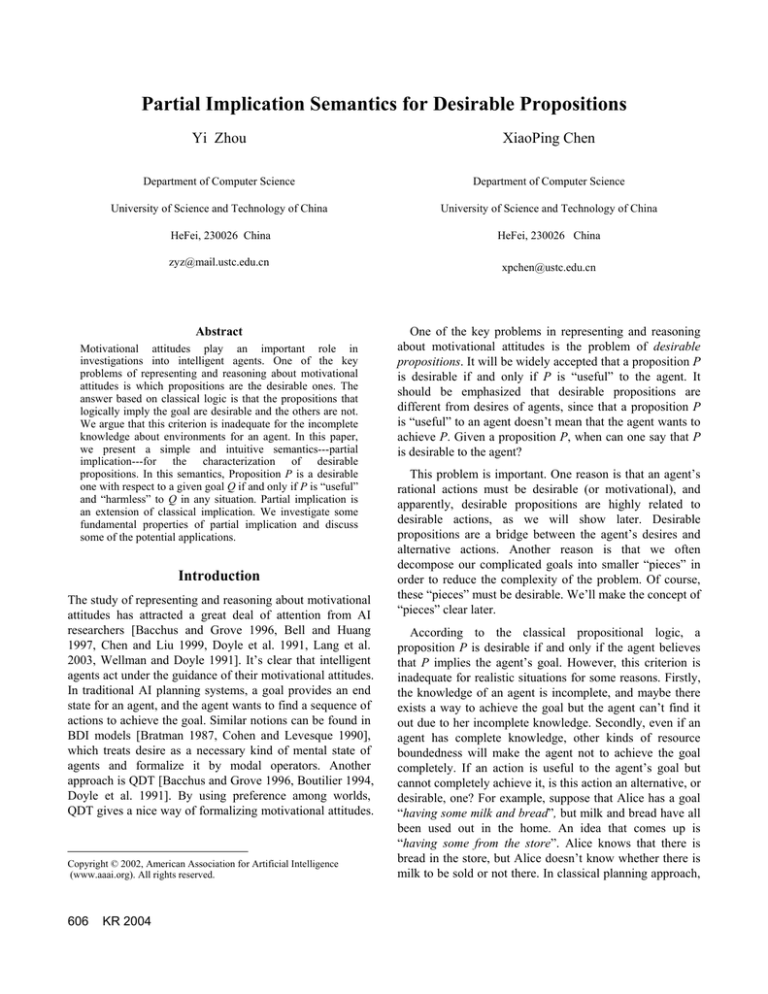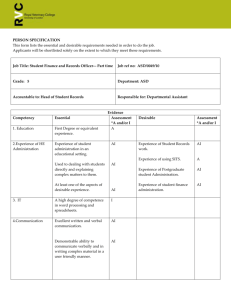
Partial Implication Semantics for Desirable Propositions
Yi Zhou
XiaoPing Chen
Department of Computer Science
Department of Computer Science
University of Science and Technology of China
University of Science and Technology of China
HeFei, 230026 China
HeFei, 230026 China
zyz@mail.ustc.edu.cn
xpchen@ustc.edu.cn
Abstract
One of the key problems in representing and reasoning
about motivational attitudes is the problem of desirable
propositions. It will be widely accepted that a proposition P
is desirable if and only if P is “useful” to the agent. It
should be emphasized that desirable propositions are
different from desires of agents, since that a proposition P
is “useful” to an agent doesn’t mean that the agent wants to
achieve P. Given a proposition P, when can one say that P
is desirable to the agent?
Motivational attitudes play an important role in
investigations into intelligent agents. One of the key
problems of representing and reasoning about motivational
attitudes is which propositions are the desirable ones. The
answer based on classical logic is that the propositions that
logically imply the goal are desirable and the others are not.
We argue that this criterion is inadequate for the incomplete
knowledge about environments for an agent. In this paper,
we present a simple and intuitive semantics---partial
implication---for the characterization of desirable
propositions. In this semantics, Proposition P is a desirable
one with respect to a given goal Q if and only if P is “useful”
and “harmless” to Q in any situation. Partial implication is
an extension of classical implication. We investigate some
fundamental properties of partial implication and discuss
some of the potential applications.
Introduction
The study of representing and reasoning about motivational
attitudes has attracted a great deal of attention from AI
researchers [Bacchus and Grove 1996, Bell and Huang
1997, Chen and Liu 1999, Doyle et al. 1991, Lang et al.
2003, Wellman and Doyle 1991]. It’s clear that intelligent
agents act under the guidance of their motivational attitudes.
In traditional AI planning systems, a goal provides an end
state for an agent, and the agent wants to find a sequence of
actions to achieve the goal. Similar notions can be found in
BDI models [Bratman 1987, Cohen and Levesque 1990],
which treats desire as a necessary kind of mental state of
agents and formalize it by modal operators. Another
approach is QDT [Bacchus and Grove 1996, Boutilier 1994,
Doyle et al. 1991]. By using preference among worlds,
QDT gives a nice way of formalizing motivational attitudes.
Copyright © 2002, American Association for Artificial Intelligence
(www.aaai.org). All rights reserved.
606
KR 2004
This problem is important. One reason is that an agent’s
rational actions must be desirable (or motivational), and
apparently, desirable propositions are highly related to
desirable actions, as we will show later. Desirable
propositions are a bridge between the agent’s desires and
alternative actions. Another reason is that we often
decompose our complicated goals into smaller “pieces” in
order to reduce the complexity of the problem. Of course,
these “pieces” must be desirable. We’ll make the concept of
“pieces” clear later.
According to the classical propositional logic, a
proposition P is desirable if and only if the agent believes
that P implies the agent’s goal. However, this criterion is
inadequate for realistic situations for some reasons. Firstly,
the knowledge of an agent is incomplete, and maybe there
exists a way to achieve the goal but the agent can’t find it
out due to her incomplete knowledge. Secondly, even if an
agent has complete knowledge, other kinds of resource
boundedness will make the agent not to achieve the goal
completely. If an action is useful to the agent’s goal but
cannot completely achieve it, is this action an alternative, or
desirable, one? For example, suppose that Alice has a goal
“having some milk and bread”, but milk and bread have all
been used out in the home. An idea that comes up is
“having some from the store”. Alice knows that there is
bread in the store, but Alice doesn’t know whether there is
milk to be sold or not there. In classical planning approach,
Alice will do nothing because there is no way to completely
achieve the goal according to her current knowledge. This
is not appropriate or adequate for an autonomous agent in
unpredictable environments.
Previous work on qualitative decision theory mainly
focus on the preference among alternative propositions. In
preference semantics one can determine whether one
proposition is more desirable than another and thus make
decisions correspondingly. We believe that desirability is of
the same importance as preference in rational decision
making. There are some significant differences between the
desirable ones and undesirable ones. As in the milk case,
“having some milk” is the desirable one yet “having some
tea” is not. Although we can represent this distinction in
QDT, we cannot explain why the former is desirable and
the latter is not, all we know is that the former is more
desirable than the latter according to our preference over
worlds. In this paper we’ll provide an alternative approach
to clarify the inherent propositional relation between the
agent’s goals and the desirable propositions.
We believe that there are different sorts of desirable
propositions. In this paper, we concentrate on formalizing a
certain kind, called partial desirable propositions. We
extend the classical implication into partial implication,
denoted by Γ |= P f Q, meaning that under any
circumstance Γ , if P is true, then Q will be “partially” true.
Technically, we employ and generalize the semantic theory
Lmp4c [Chen and Liu 1999] and prime implicant [Marquis
2000] to formalize partial implication. Unlike Lmp4c, here
we use a two-valued semantics instead of four-valued one.
The rest of this paper is organized as follows. We clarify
the notion of desirable propositions and partial implication
in section 2. In section 3 we formalize our criterion by
prime implicant and investigate its main properties. Then
we define a kind of desirable proposition based on partial
implication and show how this definition relates to some
key problems in desire representation in section 4. At last
we draw our conclusions.
Informal discussion
The concept of desirable propositions which we try to
capture in this paper is different from that of desires
appeared in existing literature. According to existing
literature a proposition P is a desire if the agent wants to
achieve P. On the other hand, we call a proposition P a
desirable proposition if P is desirable to some extent, i.e.,
at least “useful” to the agent’s goal. This idea was first
stated by Newell [Newell 1982]. In the milk case, does
Alice want “to have some bread and milk from the store”?
Not absolutely. Maybe the distance is so far that Alice
doesn’t want to go to the store. What Alice wants is just
“having milk and bread” at the right moment, “having the
bread and milk from store” is only useful with respect to
the goal. Before she decides to go to the store, this
proposition is not her traditional desires, that is, she wants
“to have bread and milk from store” only after she makes
the decision.
For the second, a desirable proposition P is relative to
one or some of the traditional desires. In the previous
example, “having the bread and milk from store” is a
desirable proposition with respect to “having some bread
and milk”. Suppose that Alice has another goal “not to be
tired”, then “having milk and bread from store” is not an
“absolutely desirable proposition” since Alice suffers from
a long walk to go to the store.
And another important thing is that the agent’s desirable
propositions are relative to the agent’s beliefs. Suppose that
someone tells Alice that the milk in the store has been sold
out and Alice believes it, then she would not take “having
some bread and milk from store” as her desirable
proposition.
Ideas relevant to desirable propositions or desirable
actions can be found in AI literature elsewhere, such as the
famous means-end analysis, I- in BOID architecture
[Broersen et al. 2001], and so on. Apparently, generating
options and weighting of options are both necessary for a
rational agent. The goal of AI planning systems is to
generate action sequences to achieve given goals from
initial state. If either of the action sequences does not
completely achieve the goal, there is no difference between
them in traditional AI planning systems. Haddawy and
Hanks [Haddawy and Hanks 1998] criticized it and used a
function from propositions to a real number to represent the
degree of satisfaction of goals. In this paper, we provide
partial implication semantics for desirable propositions
from a symbolic point of view. We focus on the partial
implication relationships between desirable propositions
and goals but not the degree of satisfaction between them.
Partial implication is an extension of classical implication
which means that under a circumstance Γ , if P is true, then
Q will be “partially” true.
Partial implication is closed under “usefulness” while
classical implication is closed under deduction. Intuitively,
that P partially implies Q can be understood as that P is
“useful and harmless” to Q in any situation, where P’s
being useful to Q means that the realization of P will cause
partial realization of Q, and P’s being harmless to Q means
that the realization of P will not damage partial realization
of Q. We will give formal definitions of usefulness and
harmlessness in our semantics.
KR 2004
607
Let’s recall the milk case. Let x= having some milk, y=
having some bread, then the goal of Alice can be
represented as G(x ∧ y). Are these following
propositions---x, z, x ∧ z, x ∧ ¬ y, x ∨ y, x ∨ z desirable
propositions of Alice (z denotes having some tea)?
According to the discussion above, the conclusion is that
x, x ∧ z, x ∨ y are desirable and the others are not. The
reason is that x ∧ ¬ y is useful but also harmful to x ∧ y;
since ¬ x ∧ z implies x ∨ z, x ∨ z is not useful to x ∧ y “in
any situation”. However, in some realistic situation, we
treat x ∨ z as a desirable proposition with respect to x ∧ y,
we think that this is another kind of desirable proposition.
Partial implication semantics
We will restrict our discussion within a propositional
language, denoted by L. The formulas of L are formed as
usual from a set of atoms, Atom= {x1, x2 …}, and the
standard connectives ¬ , ∨ , ∧ , → and ↔ . For any subset
A of Atom, let L(A) = A ∪ { ¬ a∣a ∈ A} be the set of
literals composed from A. Let Γ , Γ ’, etc denote sets of
consistent propositional formulas in L; x, y atoms; l literals;
and P, Q, R formulas in L. Atom(P) and Atom( Γ ) denote
the set of atoms appeared in P and Γ respectively.
Definition 1: ( Γ -implicant) A consistent conjunction of
literals π is a Γ -implicant of formula P, if:
(1) π is consistent with Γ ,
(2) π and Γ satisfies P.
We write Γ [P] to denote the set of the Γ -implicants of
P. A Γ -implicant is a partial truth-value assignment, under
which some atoms may have no truth-value assigned. It
represents incomplete knowledge or recognition state of an
agent. But one should notice that sometimes complete
knowledge is unnecessary and the truth-value of a formula
is determined even under a Γ -implicant. For example, let
Γ be empty, then a Γ -implicant of formula x ∨ y is {x},
only x is assigned truth, all the others are not assigned. In
this case, the truth-value of x ∨ y does not depend on that of
y. Thus a Γ -implicant can be understood as a reduced
representation of the relevant state as well.
Definition 2 ( Γ -prime implicant) A consistent
conjunction of literals π is a Γ -prime implicant of
formula P if:
(1) π is a Γ -implicant of P,
(2) There isn’t another Γ -implicant π ’ of P such that
π ’⊂ π .
We write Γ (P) to denote the set of the Γ - prime
implicant of P. We have that Γ (P) ⊆ Γ [P]. If
Atom(P) ∪ Atom( Γ ) is finite, then Γ (P) is finite.
Intuitively, a Γ -implicant of P means a way to achieve P
under Γ , but maybe redundant, and yet, a Γ -prime
implicant of P means an exact way to achieve P, all atoms
608
KR 2004
in the prime implicant are necessary. Suppose that a Γ implicant is a way to achieve formulas, and then a Γ -prime
implicant is a “least” way to achieve formulas. Each atom
in Γ -prime implicant is an “essential part”. If another
proposition makes some of the literal in a Γ -prime
implicant of P true, then it is useful to P. Moreover, if the
proposition doesn’t make the rest literals false, then it is
harmless to P. A subset of a Γ -prime implicant of P is
what we call a “pieces” of P, which is simpler than the
original goal P. In particular, if Γ is empty, we say that π
is a prime implicant of P.
Let - π be the set of negations of the literals in π .
Similar to Lmp4c, we define partial implication based on
prime implicant.
Definition 3 (Partial implication) We say that P partially
implies Q under Γ , denoted by Γ |= P f Q, if:
(1) Γ (P) is not empty.
(2) For each π ∈ Γ (P), there exists π ’ ∈ Γ (Q), such
that π ∩ π ’ is not empty and π ∩ - π ’ is empty.
The Γ - prime implicant of P π plays a dual role. Firstly,
it captures the “any situation”, all the situations must be
consistent to Γ and P will be true in the situation. And the
set Γ (P) means all possible ways to achieve P; Secondly,
π is useful (achieves part of Q, π ∩ π ’ is not empty) and
harmless ( we can achieve Q based on the contribution of P,
π ∩ - π ’ is empty) to Q, and then, P is useful and
harmless to Q through π and π ’. Thus we formally define
our intuitive definition of partial implication by using prime
implicant.
In partial implication semantics, principle of substitution
doesn’t hold. For example, we can get |= x f x ∧ y when
Γ is empty, but it is not the case that |= P f P ∧ Q for all
formulas P and Q (let P= x ∨ y and Q= ¬ y). We enumerate
some instances of the partial implication to illustrate its
characteristics over atoms first. As a matter of convenience,
we omit Γ when it is empty.
Proposition 1 (Partial implication relationships over
atoms)
(p-1) |= x f x ∧ y;
(p-2) |= x f x ∨ y;
(p-3) |= x ∧ y f x;
(p-4) |≠ x ∨ y f x;
(p-5) |≠ y f x;
(p-6) |≠ x ∧ ¬ y f x ∧ y;
(p-7) |= x ∧ z f x ∧ y;
(p-8) |= x ∨ y f (x ∨ y) ∧ z;
(p-9) |= x f x ∧ ( ¬ x ∨ y);
(p-10) |≠ ¬ x f x ∧ ( ¬ x ∨ y);
(p-11) |= x f (x ∧ y) ∨ ( ¬ x ∧ ¬ y);
(p-12) |= ¬ x f (x ∧ y) ∨ ( ¬ x ∧ ¬ y);
(p-13) {y → x} |= y f x;
(p-14) { ¬ y} |= x ∨ y f x;
(p-15) { ¬ y} |≠ x ∧ y f x;
(p-16) {z → y, y → x} |= z f x.
From (p-1) to (p-16), one can see that partial implication
is different from classical propositional implication.
Classical propositional logic is suitable for reasoning about
beliefs, not suitable for desires. In contrast with (p-5), (p-13)
illustrates the uses of preconditions. Comparison of (p1-11)
and (p1-12) indicates that a condition and its negation can
partially imply the same proposition in our model.
Theorem 2 (Equivalence) If Γ |= P ↔ Q, then
Γ |= P f R implies Γ |= Q f R; Γ |= R f P implies
Γ |= R f Q.
Theorem 3 (Relationship to classical implication) If
Γ |= P → Q and both P and Q are non-trivial under Γ ,
then Γ |= P f Q.
From theorem 3 it follows that partial implication is an
extension of classical implication.
Theorem 4 (Non-triviality) If P or Q is trivial under Γ ,
then that Γ |=P f Q doesn’t hold.
This theorem illustrates that every trivial formula does
not partially imply other formulas and can not be partially
implied either.
Lemma 5 Suppose Γ is empty, if Atom(P) ∩ Atom(Q) is
empty, then Γ (P ∨ Q)= Γ (P) ∪ Γ (Q) , Γ (P ∧ Q)=
{ π ∪ π ’ | π ∈ Γ (P), π ’ ∈ Γ (Q)}.
Theorem
6
(Conjunctive
decomposition)
If
Atom(P) ∩ Atom(Q) is empty, and P, Q are non-trivial, then
|= P f P ∧ Q .
Theorem
7
(Disjunctive
decomposition)
If
Atom(P) ∩ Atom(Q) is empty, and P, Q are non-trivial, then
|= P f P ∨ Q .
Proposition 8 (Relevant) If
Atom(P) ∩ Atom(Q) is not empty.
|= P f Q, then
Unlike relevance logic, partial implication focuses on
“partial” relationships between formulas. The antecedent
needn’t imply the consequent. For example, (p-1) and (p-7)
in proposition 1 show that some partial implication
relationship don’t hold in relevance logic.
Property 9 (Non-monotonic) There exists a formula P and
a Γ -implicant π of P such that π is not a Γ ’-implicant
of P, where Γ ’= Γ ∪ {Q}.
An example is that Γ is empty, P=x ∧ y, Q=x, π ={x, y}.
This property is also true for Γ - prime implicant. So nonmonotonicity can be found everywhere in partial
implication semantics. Such as the non-monotonicity of Γ implicant, that of Γ - prime implicant, precondition set Γ ,
etc. Among them, property 9 is the most fundamental one,
all the other non-monotonicity of partial implication can be
derived from it. Non-monotonicity is an inherent property
of desirable propositions. It’s not the same as the nonmonotonicity of beliefs.
Property 10 (Decomposition) If any intersection of sets
Atom(P1), Atom(P2) ... Atom(Pn) is empty, we can replace
these formulas by atoms.
This means that we can reduce the complexity in partial
implication semantics due to the “independence”
knowledge of agent. Similar notions can be found in QDT
[Bacchus and Grove 1996]. Theorem 6 and theorem 7 are
special examples.
Property 11 (Non-transitivity) Γ |= P f Q and
Γ |= Q f R doesn’t imply Γ |= P f R.
The reason of the untenable of transitivity is that in
some situation, the “usefulness” of P with respect to Q is
just irrelevant and redundant for the “usefulness” of Q
with respect to R. As an example, suppose Γ is empty,
then |= x f x ∧ y and |= x ∧ y f y hold, but |= x f y
does not hold. We will elsewhere strengthen partial
implication into strong one which satisfies transitivity.
Desirable proposition and related works
Desires themselves are all desirable propositions. Perhaps
the simplest definition of desirable propositions could be
given this way: propositions that imply (achieve) the
agent’s goal under the agent’s beliefs are the desirable ones.
We call these propositions (actions) strict desirable
propositions (actions).
Definition 4 (Strict desirable propositions) Let Q is the
agent’s desire and Γ is the agent’s belief set. If
Γ |= P → Q, then the P is called a strict desirable
proposition of the agent wrt Q.
We have pointed out in section 1 that this criterion is not
the unique one, and now we define partial desirable
propositions based on the semantics of partial implication.
Definition 5 (Partial desirable propositions) Let Q is the
agent’s desire and Γ is the agent’s belief set. If
Γ |= P f Q, then the P is called a partial desirable
proposition of the agent wrt Q.
The differences between partial desirable propositions
and strict desire propositions have been discussed in section
3. From theorem 4, it follows that all nontrivial cases of the
strict desirable propositions is included in partial desirable
propositions. In fact, the only inadequacy of strict desirable
propositions lies in that it does not cover all of the
KR 2004
609
interesting cases. Some of these can be found in Proposition
1.
Let’s go back to the example given in section 1. Alice
has a goal “having some milk and bread”, but milk and
bread have all been used out in the home. Alice knows that
there is bread to sell in the store, but Alice doesn’t know
whether there is milk to be sold. This is a typical
incomplete knowledge in planning. In the classical planning
approach, Alice will do nothing because there isn’t a
complete way to achieve the goal due to current knowledge.
Under the criterion of partial desirable proposition, “to go
to store” is a rational alternative action because having
some bread is a partial desirable proposition of Alice.
In this example there is no plan to completely achieve the
goal due to the incomplete knowledge of the agent; in that
case, we can take partial desirable propositions as an
alternative. It is true for many realistic situations.
The study of desirability is also related to the well-known
BDI modeling. A relevant question is where do intentions
come from? Cohen and Levesque gave an answer that
intentions are choices with commitment to goals [Cohen
and Levesque 1990]. However, we believe that intentions
should be chosen from desirable ones, but not from goals
directly. The distinction is significant in that one should
derive desirable propositions from goals and choose some
of them with commitment as one’s intentions. This provides
a possibility of developing some mechanism for deriving
intentions automatically and thus a chance of connecting
BDI models more directly with certain types of behaviors.
An essential problem in representation of desires is
that an agent’s desires seem to relate with her beliefs.
Such as the example of rain and umbrella [Wellman and
Doyle 1991], suppose there are three independent logical
propositions: W, “I’m wet”; R, “It rains”; U, “I’m going
out with an umbrella”. We assume that ¬ U is preferred
to U, but U is preferred to ¬ U by given R. Boutilier
[Boutilier 1994] formalized it by conditional desires,
which I(B|A) means that “If A, do B”. The example can
be represented as {I( ¬ U|True), I(U|R)}. We here
elaborate the examples by desirable propositions. The
mental states of the agent can be represented as {D( ¬ W),
B( ¬ R → ¬ W), B(R ∧ U → ¬ W)}. We can derive
from partial implication semantics that {R, ¬ R → ¬ W,
R ∧ U → ¬ W} |= U f ¬ W; { ¬ R, ¬ R → ¬ W,
R ∧ U → ¬ W} |≠ U f ¬ W. So U partially implies
¬ W by given R and does not by given ¬ R, U is a
desirable proposition by given R and is not by given ¬ R.
The studies of desirable propositions provide another
perspective on the relation between desires and beliefs.
610
KR 2004
Conclusion
This paper contains two main contributions. First, we point
out the difference between traditional “desires” and
“desirable propositions”, and analyze the roles of desirable
propositions. We expound the inadequacy of the simple
criterion of desirable propositions which is based on
classical logic. Second, we present a logical semantics to
capture the notion of partial implication---being both useful
and harmless. Based on this semantics we define a novel
criterion of desirable propositions. Our analyses show that
the new criterion is necessary and appropriate in some
realistic situations.
Notice that strict and partial desirable propositions are
not the only possible criterions of desirable propositions, so
further investigations into desirable propositions might be
taken in the future. Another deserving work is to integrate
desirability and preference. Also the first-order
formalization of partial implication is worth pursuing.
Acknowledgement
This work has been supported by NSFC of China
(60275024). We thank Zhisheng Huang for his valuable
suggestions and comments, and also thank Yajun Wang ,
Zhuo Huang and ShiZhuo Zhu for their useful comments.
Specially, we thank the anonymous reviewers of this paper
for their advices.
References
[1] F. Bacchus and A. Grove, 1996. Utility independence in
qualitative decision theory. In proceedings of KR’96,
pages 542-552. Morgan Kaufmann, San Francisco,
California.
[2] J. Bell and Z. Huang. 1997. Dynamic goal hierarchies.
In J. Doyle and R. H. Thomason, editors, Working
Papers of the AAAI Spring Symposium on Qualitative
Preferences in Deliberation and Practical Reasoning,
pages 9-17, Menlo Park, California. AAAI.
[3] C. Boutilier. 1994. Toward a logic for qualitative
decision theory. In Proceedings of KR’94, 75-86.
Morgan Kaufmann.
[4] M. E. Bratman. 1987. Intentions, Plans, and practical
reasoning. Harvard University Press, Cambridge Mass.
[5] J. Broersen, M. Dastani, Z. Huang, J. Hulstijin and van
der Torre. 2001. The BOID architecture. In proceedings
of AGENT’01.
[6] Xiaoping Chen and Guiquan Liu. 1999. A logic of
intention, in: Proceedings of IJCAI-99, 1999, 172-177.
[7] P. R. Cohen, H. J. Levesque. 1990. Intention is Choice
With Commitment, Artificial Intelligence, 42, 213-261.
1997.
[8] F. Dignum, D. Kinny and L. Sonenberg,
Formalizing motivational attitudes of agents: On desires,
obligations and norms. In proceedings of the 2nd
IWCEE on MAS.
[9] J. Doyle, Y, Shoham, and M. P. Wellman. 1991. A logic
of relative desire, in: Proc. of the 6th IS on
Methodologies for Intelligent Systems, Pages 16-31.
[10] P. Haddawy and S. Hanks. 1998. Utility models for
goal-directed
decision-theoretic
planners.
Computational Intelligence, 14(3): 392-429.
[11] J. Lang, L. van der Torre, E. Weydert. 2003. Hidden
Uncertainty in the Logical Representation of Desires. In
Proceedings of IJCAI’03.
[12] P. Marquis. 2000. Consequence finding algorithms. In
D.Gabby, Handbook of Defeasible reasoning and
Uncertainty Management Systems(V), pp, 41-145.
Kluwer.
[13] A. Newell. 1982. The knowledge level. Artificial
Intelligence, 18(1): 87-127.
[14] M. P. Wellman and J. Doyle. Preferential semantics for
goals. 1991. In proceedings of AAAI’91, pages 698703, Menlo Park, California. AAAI Press.
KR 2004
611







